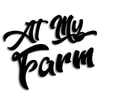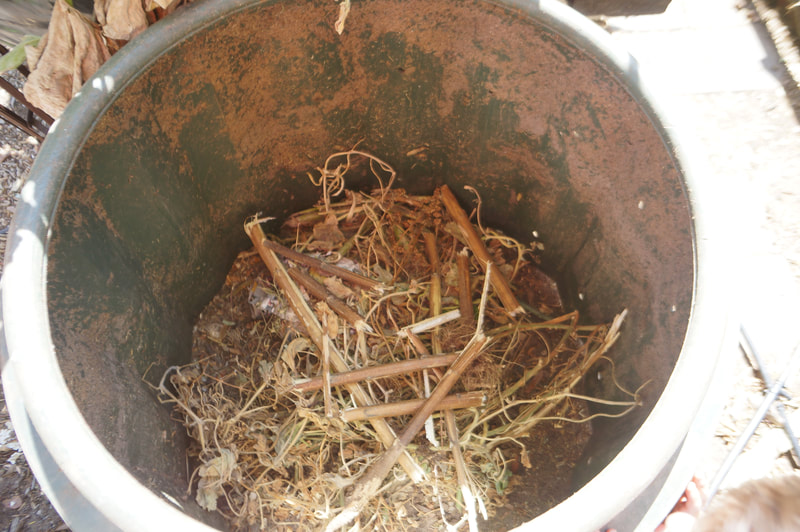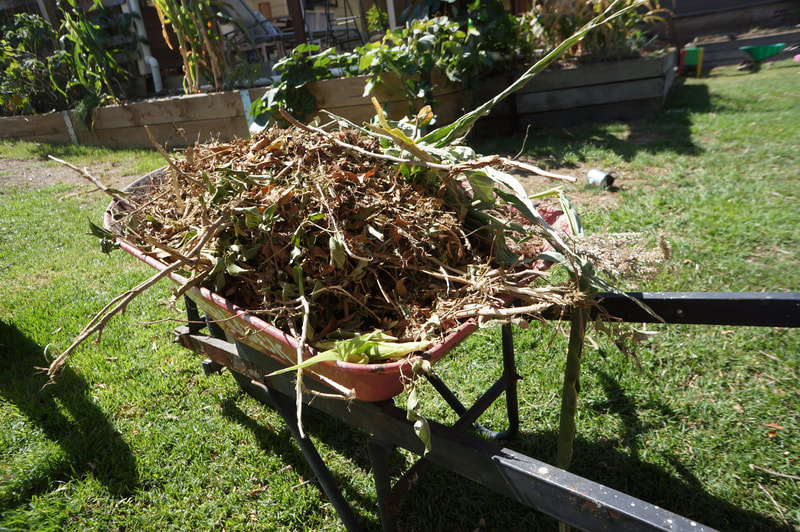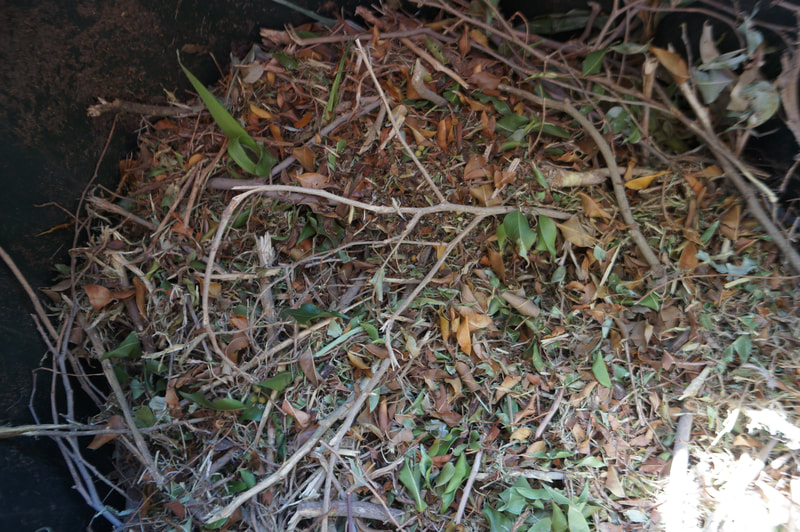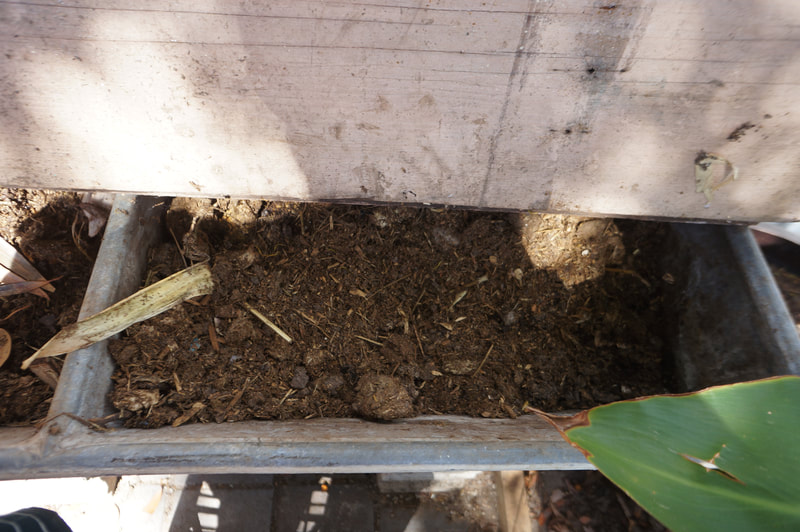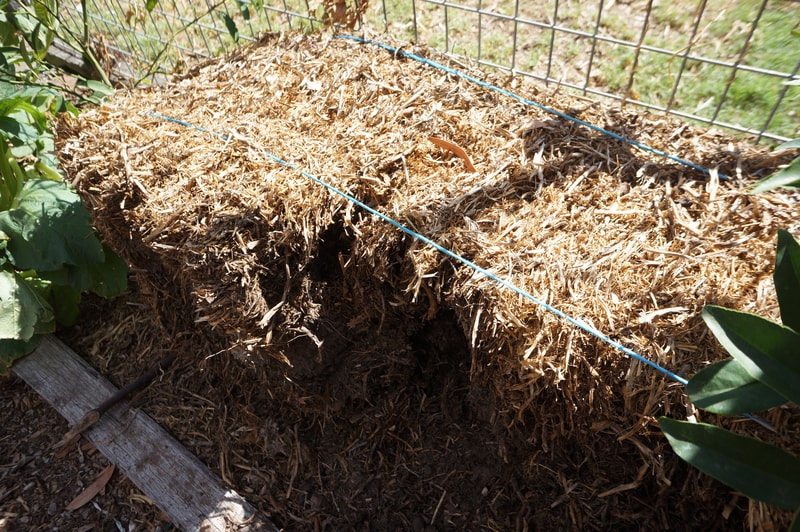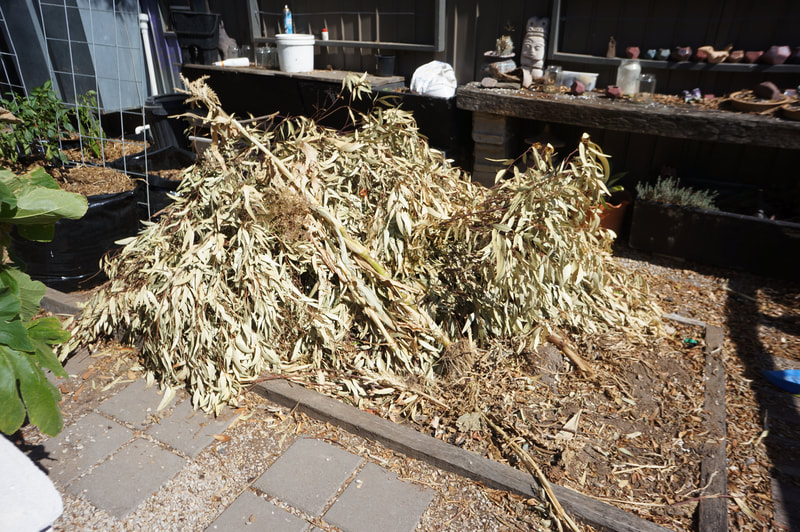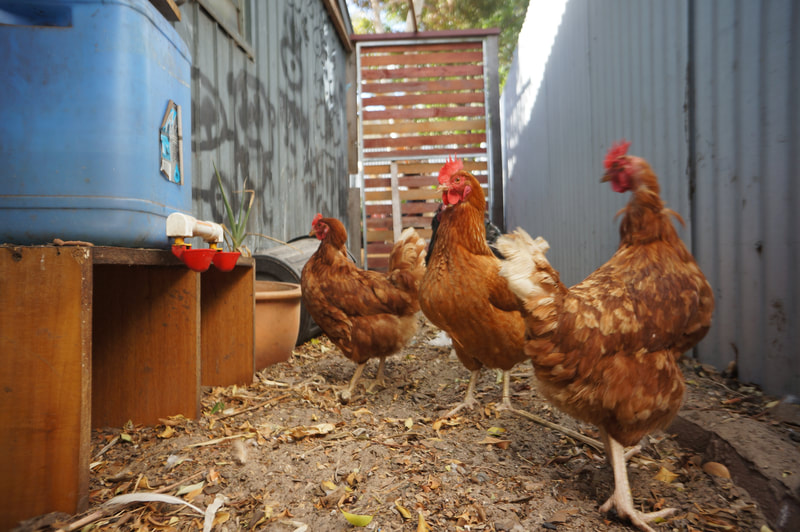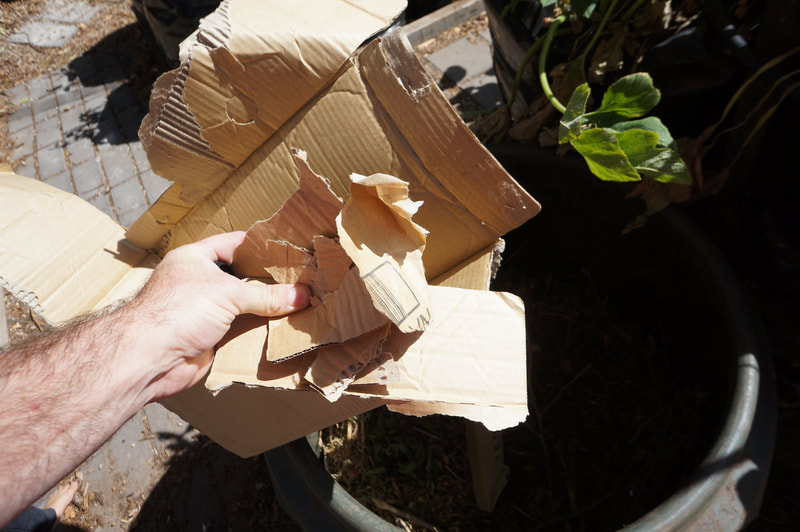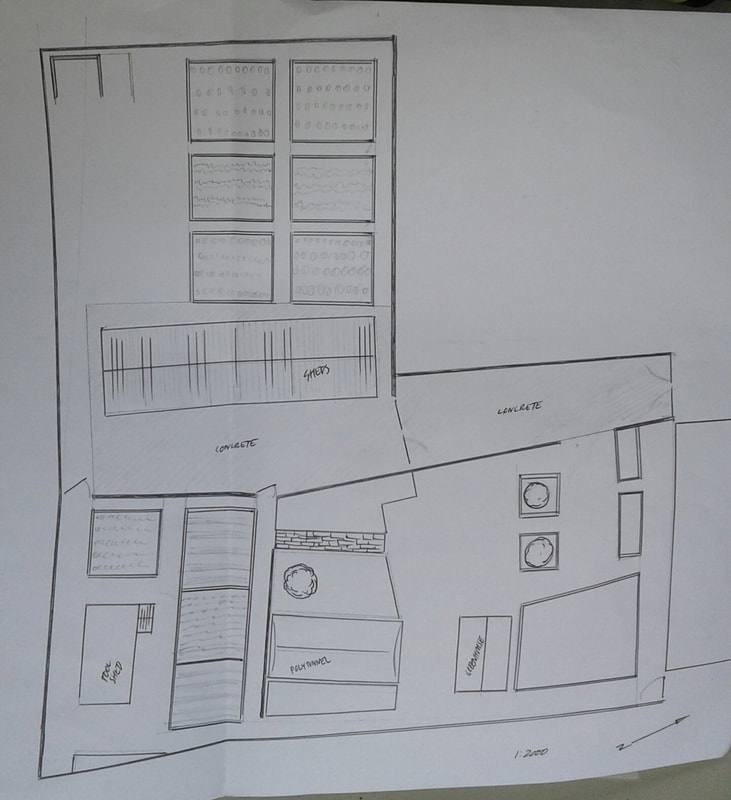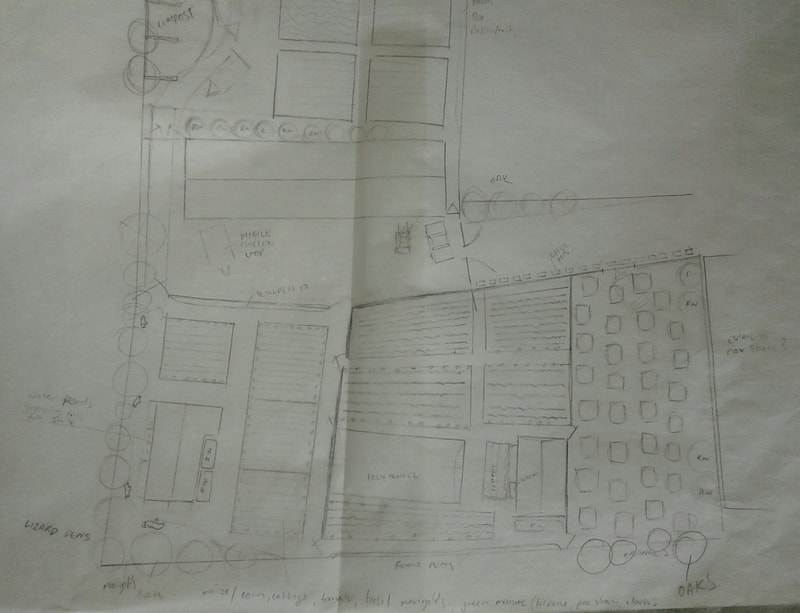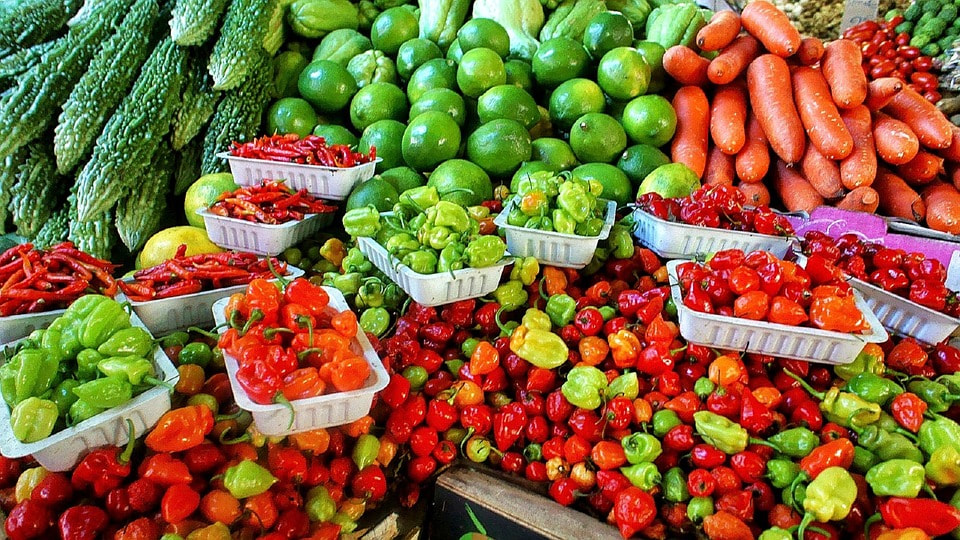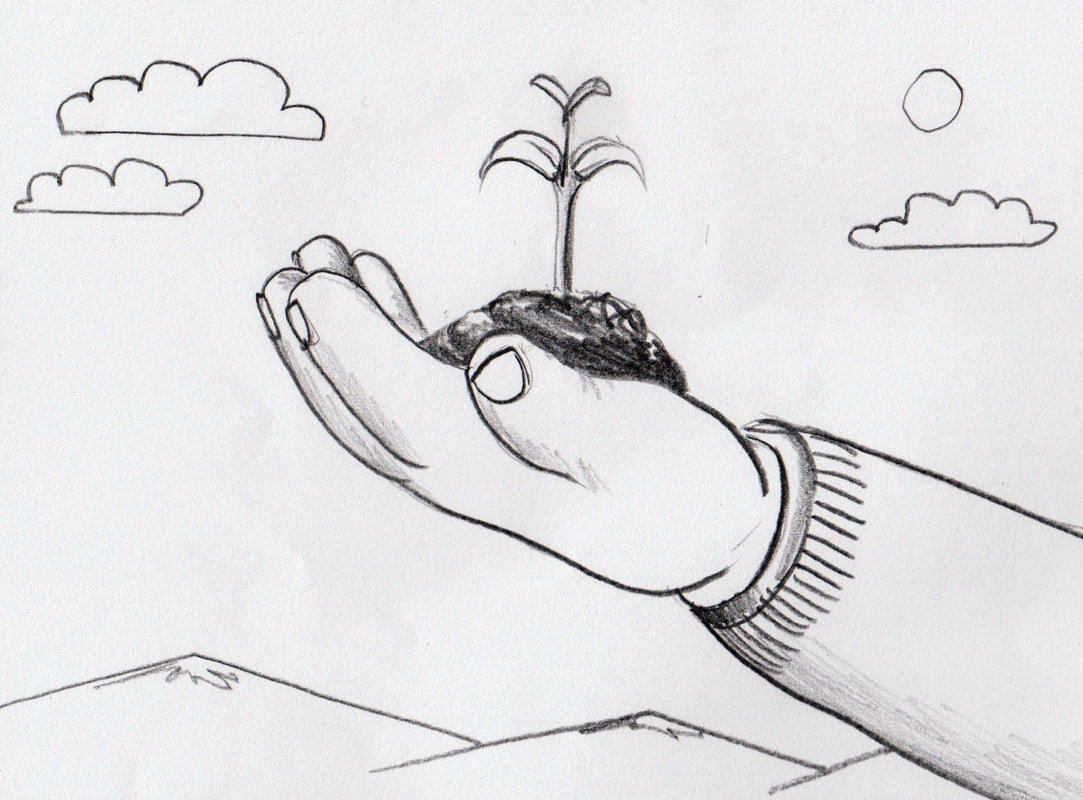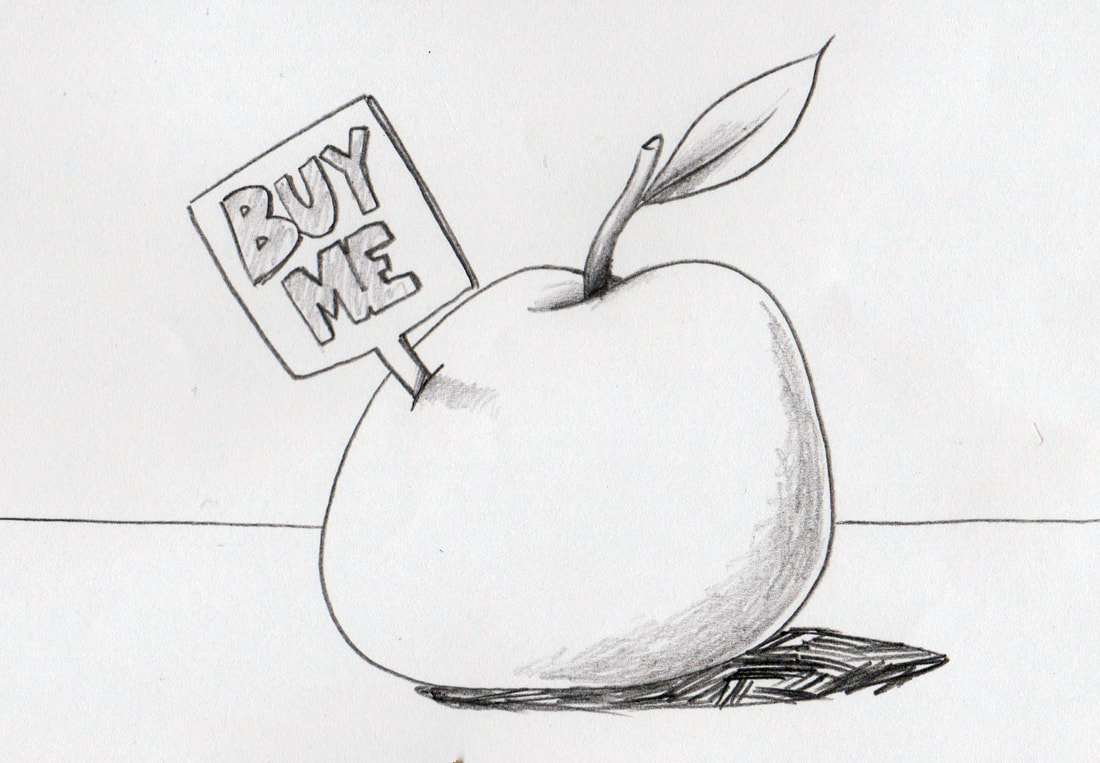|
I just emptied out my compost into my no dig garden bed so it's time to start again. I always have a few branches and sticks lying about so I start with them first. Layered over each other crisscross, the web of sticks ensures aeration at the bottom of the pile.
Some shredded cardboard is next and then a pile of freshly mowed leaves. Once doused with water I've then gone to the worm farm to get a scoop of dirt that will no doubt contain plenty of useful micro organisms. Every few days the kitchen scraps bin from the kitchen gets emptied into the compost. The kitchen scraps bin always has shredded newspaper mixed in with the kitchen scraps. I find it absorbs the moisture and doesn't get that vinegar smell as much. Adding to the heap from here is a case of what becomes available but always being aware of having a balance of wood chips, sticks etc to fresh green waste. I have a lot of debris around the garden from trees so I'm often mowing up leaves and sticks at the same time. This mixed in with the lawn clippings always gets the ball rolling with the temperature of the heap. Ensuring the heap has a good moisture content is important too, and sometimes it will get a flush from the hose. Having a bin with a lid keeps the heat and moisture in but it does make it a little harder to turn, I usually stick in a fork and try to move it about, particularly trying to loosen up the centre. I've got chickens so their manure always ends up in the bin. So do their egg shells and feathers for that matter. Any garden waste such as corn stalks, bean vines, broccoli stems all get thrown on the lawn to be mowed up and placed in the bin. After a growing season or two has passed and I know I am going to empty the bin soon I stop placing new waste in the bin and I stockpile the waste, trying to hold off on adding more. I want to ensure that what is in the bin has had enough time to rot down. Then the bin gets emptied and I start again.
0 Comments
After talking to organic farmers, one of the main pieces of advice was to maximize the use of space. So when I looked at the existing site I noticed that over one third of the land was not being used. This became one of the major aims of the redesign. Secondary aims were to introduce animals that could be farmed and provide manure on site and also introducing the use of rainwater which the site currently does not use at all. The current site has an existing tool shed, a large storage / work shed / processing area, and a greenhouse and a polytunnel. A small compost heap (more of a dumping ground than anything) a large concrete driveway, 10 raised garden beds, existing fences and gates make up the remaining significant features. Multiple uses, erosion control, grazing rotation, crop rotation.
Chickens have been introduced into the design to provide manure, eggs and a degree of pest and weed control. A number of mobile chicken tractors would be used to house the birds so that grazing can be contained to the 3 sections of the farm to enact a grazing rotation. Corn is grown as windbreaks around crops as wind erosion is one of the major concerns for this site. The corn is able to be used as chicken feed. Other crops are based on rotations that the site already uses and have been successful in the climate and soil. They are cabbage and other brassicas, along with tomatoes. Tomatoes supposedly help deter cabbage grub. Companions are added to this duo such as basil and marigolds. A green manure crop including pea, chicory, clovers and lucerne can also be used as a feed crop for the chickens and is part of the rotation in the raised beds. A large area of unused spaces around the greenhouses has been designed to support an orchard. Citrus, Quinces, nectarines, apricots, olives, plums, cherries, figs, grapes, pomegranates, almonds, walnuts, chestnuts would all be recommendations. Using espalier techniques may be beneficial to maximise the plants number sin a smaller space. Chickens are used here for weed and pest control. Oak trees are grown around the edges of the property where possible, both as a windbreak and home for wildlife. The oaks have a protective action on citrus and the leaf mulch can be used to deter slugs. Slugs and snails are the main pest currently so habitats for lizards have been added to the design, creating small caves under dead logs and among rocks. A pond is also added to attract beneficial wildlife while also having the ability to be used for growing water flowers or an edible crop. Composting has been expanded with multiple heaps and a worm farm. Fences and barriers are used as trellis to support beans, passionfruit, kiwi or other climbers. A large concreted area of the farm is also underutilized, so creating planter boxes where crops can be grown would be a way to maximise the space. Growing garlic in moveable planters is an idea so that the planters can then be shifted into areas to deter pests. As many rainwater tanks as possible have been added to the design as there is not a single tank currently on site. Traffic is set to the walkways. Any large transport could only travel over the concrete areas. The remaining land is dealt with by machinery no larger than a walk behind tractor due to the small scale of the operation, the bonus being less damage to the soil. After harvest, organically certified row cover is recommended to eliminate light, kill weeds and promote worms. Cover is removed, compost added and broad forked, ready for planting. Finally the design also adds a beehive to give our special little friends an on site home. There are a range of agricultural techniques and approaches that are sustainable and have either a light impact or no impact at all on our environment. In fact, there is potential for certain approaches to build on and improve an environment. Here are 4 approaches that offer a sustainable approach to agriculture : Hydroponics is growing plants without the use of soil, sometimes with the plant roots directly in water or otherwise with the roots in growing media. A mineral solution is pumped through the grow beds to supply nutrients to the plants. As the water recirculates it tends to be more water and nutrient efficient than regular growing in soil. The grower also has greater control over how much and which nutrients are absorbed by the plants. Permaculture focuses on a balanced and diverse approach to design and agriculture. By emulating natural patterns that appear in existing successful ecosystems a strong and resilient environment can be created that sustainably supports itself. Biodynamics aims to develop the farm as a total organism. A good analogy is the human body - feed the body fats and sugars and it will change for the worse, teeth rot, the skin blemishes and arteries clog. The land is the same. Expose the body to chemicals and it will react in an adverse manner the way soil does. Biodynamics focuses on healthy soil, the essential basis for healthy plants and animals. The soil structure is enhanced through using organic farm based products that work directly with the dynamic biological processes and cycles of soil fertility. Organic certified uses national standards of farming and growing processing of produce. Regulations set certain standards as to where livestock feed comes from, what seed can be used for crops, what fertilisers can be used etc. to ensure that no synthetic pesticides, growth hormone, antibiotics or genetically modified products are used. The methods used have an overall aim of balance and diversity and steers away from monocultures ultimately seeking to increase sustainability and to work with existing ecological cycles and systems.
To remain viable farmers need to address a range of issues. Sustainable agriculture is now a well recognised approach and farmers understand and welcome the need to follow these practices. For an enterprise to remain successful in the long term they must farm sustainably. Many farmers I have spoken to say that in the 80's no one really cared too much about such practices but they quickly got on board when they saw the problems that erosion and salinity were causing. The success of the Landcare initiative has made it so that sustainable farming is now a given.
If an enterprise continues to achieve sustainable practices that improve their farm environment and add productivity to it then to be financially viable they need to focus on being competitive. Remaining competitive in a market containing cheaper, though often lesser quality products from overseas relies heavily on good marketing and creating better consumer awareness. One of our main growing regions lies only 25 minutes out of the city, so why would we want to buy products that are transported in cold storage long distances, often with little understanding of how or where they were grown? Convenience plays a big part. Consumers are often time stretched and want to go to one big supermarket to purchase all of their products in the one place. Often these supermarkets require fruit and vegetables that have good shelf life and won't blemish if they take a few bumps in transport. Unfortunately this means that the varieties of produce selected for growing are chosen for just that and not necessarily for taste or nutrition. This is where farmers can address their marketing strategies, pushing their product as organic, local, fresh and nutritious and created sustainably. Good communication with retailers is an important issue to focus on for any farmer, local marketing and making sure people buy local and have a preference to do so is also key. Diversity of products is another aspect of success. A farmer who has the ability to shift to the consumer's interests or even define a consumer's interest is always going to have an edge over other wholesalers by promoting a quality product that people will want to buy. There is a section of the market that seek out new products and look for variety. Value adding to an already successful product also helps. We see it all of the time, take olive oil for example. You can buy olive oil with chilli, with garlic or infused with lemon. People will always pay for quality products so attaining a consistent standard will ensure that a farming enterprise will remain viable. Food is a necessity and the sustainable farming of fresh organic produce along with the ability to create and cleverly market a product that is just as good, if not better than an import is critical but remember, maintaining a standard can make or break a business. One poor batch of produce could turn a fickle consumer away permanently. |
Organics &Sustainabilityfeatures
All
Archives |
